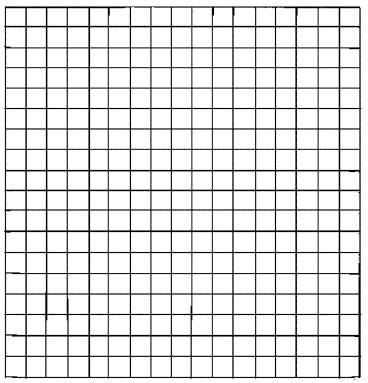|
Home |
Investigating Liner Equations Using Graphing CalculatorActivity 5
|
|||||||||||||||||||||||||||||||||||||||||||||||||||||||||||||||||||||||||||||||||||||||||||||||||||||||||
| Distance 1-10km | Money Owed (Dollars) | ||
| Chris | Natalie | Grace | |
| 0 | 0.00 | 0.00 | 4.00 |
| 1 | 1.50 | 2.50 | 4.75 |
| 2 | |||
| 3 | |||
| 4 | |||
| 5 | |||
| 6 | |||
| 7 | |||
| 8 | |||
| 9 | |||
| 10 | |||
Use the grid below to answer question #2.
2. On the same coordinate grid, make a graph for each of
the three pledge plans.
Use a line to connect the points. Remember to give your graph a title, label
your
axes, and show the scale on each axis.

3. Use graphing calculator to check your graph.
Suggested Window
Xmin = 0
Xmax = 10
Xscl = 1
Ymin = 0
Ymax = 25
4. For each of the three plans, describe in your own
words, the relationship between
the money earned and the distance walked.
5. Write an equation that can be used to compute the money owed under each
pledge plan. Use M to represent the money owed and d to represent the distance
the student walks.
6. State the slope and the y-intercept for each of the above equations.
7. Describe how increasing the amount of the pledge per kilometer affects the
table,
the graph, and the equations.
8. Does the amount of the pledge per kilometer in question #7 relate to the
slope of
the line? How does it relate? Explain.
9. Describe what is different about Grace’s plan. What happens in the table, the
graph, and the equation when Grace’s plan is introduced?
Challenge:
10. Write your own pledge plan and sketch its graph. Make your own axes and show
the labels and scale. Use the graphing calculator to check your graph.
Activity 6
Scatter Plot and Line of best Fit
Objectives:
• Using the graphing calculator, graph a scatter plot of two related variables.
• Graph the” line of best fit”.
• Interpolate and extrapolate points in your data.
Collect data of the height (in inches) and the weight (in pounds) of each
member in your family. Make a table of your data and bring it to math class (At
least 8 entries).
1. Make a scatter plot of your data on a grid paper. Remember to show a title,
label
and scale on each axis. Draw the line of best fit.
2. Use the graphing calculator and graph the scatter plot for your data.
3. Follow the graphing calculator manual or your teacher’s instruction to show
the line
of best fit on your calculator’s screen.
4. Compare the graph of the calculator with your graph on the grid paper. Are
they the
same? ________. Are they different? Why? ____________________________
5. Use the “trace” feature and the line of best fit to interpolate and
extrapolate the
weight and height of an absent (or a virtual) family member. Examples of what
you
need to find are explained below.
Interpolate:
What would be the weight of a family member whose height is in between the
shortest and the tallest of your family? (The point is somewhere inside your
data)
Extrapolate:
What would be the weight of a family member whose height is shorter than the
shortest, or taller than the tallest family member? (The point is somewhere
outside your data).
6. Use the “linear regression” feature of the graphing calculator to find the
slope and yintercept
of the line of best fit.
7. Write the equation of the line of best fit. _______________________________
Challenge:
Show on a piece of paper, how you would use the slope and y-intercept of the
line of
best fit to interpolate and extrapolate the height and weight of the two virtual
family
members in question #4. Did you get the same result?
|
Criteria |
Points | ||||
| 4 | 3 | 2 | 1 | ||
| Assignment Completeness |
All items attempted. |
90% of items attempted. |
At least 50% of all items attempted. |
Less than 50% of all items attempted. |
____ |
| Accuracy | All items are correct. |
90% of items are correct. |
Between 50% and 90% of items are correct. |
Less than 50% of all items are correct. |
____ |
| Graph Neatness |
All sketches / graphs are neatly drawn. All lines are straight, and all axes are labeled with correct scale showing. |
90% of graphs are neatly drawn, with straight lines, labeled axes and correct scale showing. |
At least 50% of graphs are neatly drawn, with straight lines, labeled axes and correct scale showing. |
Less than 50% of graphs are neatly drawn, with straight lines, labeled axes and correct scale showing. |
____ |
| Demonstrated Knowledge |
Shows complete understanding of the questions, mathematical ideas, and processes. |
Shows substantial understanding of the problem, ideas, and processes. |
Response shows some understanding of the problem. |
shows a complete lack of understanding for the problem |
____ |
| Requirements | Goes beyond the requirements of the problem. |
Meets the requirements of the problem. |
the problem. Does not meet the requirements of the problem. |
____ | |
| Legibility | Legible handwriting, typing or printing. |
Marginally legible handwriting, typing, or printing. |
Writing is not legible in places. |
Writing is not legible. |
____ |
| Total -->" | |||||
Teacher’s comments: ________________________________________________
1. What did you learn from these activities?
2. What did you like best about these activities?
3. What was most difficult about these activities?
4. What would you do differently next time?
5. What do you think your teacher should do differently next time

